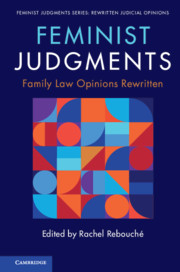Book contents
- Feminist Judgments: Family Law Opinions Rewritten
- Feminist Judgments Series Editors
- Advisory Panel for Feminist Judgments Series
- Feminist Judgments: Family Law Opinions Rewritten
- Copyright page
- Contents
- Advisory Panel for Feminist Judgments: Family Law Opinions Rewritten
- Contributors
- Acknowledgments
- 1 Introduction
- 2 Commentary on Reynolds v. United States
- 3 Commentary on McGuire v. McGuire
- 4 Commentary on Dandridge v. Williams
- 5 Commentary on Wisconsin v. Yoder
- 6 Commentary on Marvin v. Marvin
- 7 Commentary on Kulko v. Superior Court of California
- 8 Commentary on Daly v. Daly
- 9 Commentary on Michael H. v. Gerald D.
- 10 Commentary on DeShaney v. Winnebago County Department of Social Services
- 11 Commentary on Simeone v. Simeone
- 12 Commentary on Borelli v. Brusseau
- 13 Commentary on Turner v. Rogers
- 14 Commentary on In the Matter of the Parentage of a Child by T.J.S. and A.L.S.
- 15 Commentary on Matter of A-B-
- 16 Commentary on Sessions v. Morales-Santana
- Index
4 - Commentary on Dandridge v. Williams
Published online by Cambridge University Press: 08 July 2020
- Feminist Judgments: Family Law Opinions Rewritten
- Feminist Judgments Series Editors
- Advisory Panel for Feminist Judgments Series
- Feminist Judgments: Family Law Opinions Rewritten
- Copyright page
- Contents
- Advisory Panel for Feminist Judgments: Family Law Opinions Rewritten
- Contributors
- Acknowledgments
- 1 Introduction
- 2 Commentary on Reynolds v. United States
- 3 Commentary on McGuire v. McGuire
- 4 Commentary on Dandridge v. Williams
- 5 Commentary on Wisconsin v. Yoder
- 6 Commentary on Marvin v. Marvin
- 7 Commentary on Kulko v. Superior Court of California
- 8 Commentary on Daly v. Daly
- 9 Commentary on Michael H. v. Gerald D.
- 10 Commentary on DeShaney v. Winnebago County Department of Social Services
- 11 Commentary on Simeone v. Simeone
- 12 Commentary on Borelli v. Brusseau
- 13 Commentary on Turner v. Rogers
- 14 Commentary on In the Matter of the Parentage of a Child by T.J.S. and A.L.S.
- 15 Commentary on Matter of A-B-
- 16 Commentary on Sessions v. Morales-Santana
- Index
Summary
Junius and Jeanette Gary were married in Baltimore, Maryland in 1952. During the early years of their marriage, Jeanette suffered several miscarriages and was told that she could not have children. Much to their surprise, Jeanette eventually gave birth to eight children. The pregnancies took a toll on Jeanette’s health and an automobile accident left Junius also unable to work any longer. The Gary family survived on public assistance through the federal welfare program, Aid to Families with Dependent Children (AFDC). However, Maryland’s maximum grant regulation – a provision that placed an upper limit on welfare payments regardless of the number of children in the family – made it difficult for the Gary family to live under one roof. Yet Junius and Jeanette “shared one overriding goal: to keep the family together at any cost.”1 As their son Junius Jr. later explained: “Life was a constant struggle to make ends meet. There were hungry days. We had to ration. We sometimes only ate once or twice a day.”2 The Gary family sued to enjoin Maryland’s welfare scheme as violating both federal statutory law and the Equal Protection Clause. The case ultimately reached the U.S. Supreme Court, which upheld “family caps” on subsistence payments to poor families in Dandridge v. Williams.3
- Type
- Chapter
- Information
- Feminist Judgments: Family Law Opinions Rewritten , pp. 62 - 94Publisher: Cambridge University PressPrint publication year: 2020



